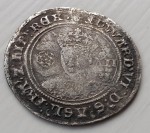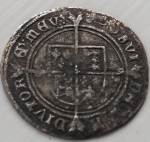 Retired security system specialist Bruce Campbell (no relation to Ash from Evil Dead) was looking for Victorian-era coins and artifacts along the Gorge Waterway in Victoria, British Columbia, on December 13th, 2013, when he found a coin buried three or four inches deep in the mud flats at low tide. It was so caked in the area’s characteristic blue clay that he couldn’t identify it. He posted pictures of his finds — an 1891 Canadian nickel, a 1960s a silver dime, an early Canadian penny and the mystery coin — on the Official Canadian Metal Detecting forum where he is a moderator. It was the clay-caked coin that aroused the most interest of the forum denizens, some of whom recognized it as a rare silver shilling from the brief reign of King Edward VI, son of Henry VIII and half-brother of Elizabeth I.
Retired security system specialist Bruce Campbell (no relation to Ash from Evil Dead) was looking for Victorian-era coins and artifacts along the Gorge Waterway in Victoria, British Columbia, on December 13th, 2013, when he found a coin buried three or four inches deep in the mud flats at low tide. It was so caked in the area’s characteristic blue clay that he couldn’t identify it. He posted pictures of his finds — an 1891 Canadian nickel, a 1960s a silver dime, an early Canadian penny and the mystery coin — on the Official Canadian Metal Detecting forum where he is a moderator. It was the clay-caked coin that aroused the most interest of the forum denizens, some of whom recognized it as a rare silver shilling from the brief reign of King Edward VI, son of Henry VIII and half-brother of Elizabeth I.

 The coin is one millimeter thick and 33 millimeters in diameter and was minted at the Tower of London between 1551 and 1553. On the obverse is a bust of the young king crowned facing left. It is inscribed EDWARD VI D G AGL FRA Z HIB REX (Edward VI by the Grace of God King of England, France and Ireland). On the reverse is a shield bearing the royal coat of arms over a long cross fourchee, a heraldic term for a cross where the end of each arm is forked. The inscription reads POSUI DEU ADIUTORE MEUM (I have made God my helper).
The coin is one millimeter thick and 33 millimeters in diameter and was minted at the Tower of London between 1551 and 1553. On the obverse is a bust of the young king crowned facing left. It is inscribed EDWARD VI D G AGL FRA Z HIB REX (Edward VI by the Grace of God King of England, France and Ireland). On the reverse is a shield bearing the royal coat of arms over a long cross fourchee, a heraldic term for a cross where the end of each arm is forked. The inscription reads POSUI DEU ADIUTORE MEUM (I have made God my helper).
This is a significant coin for many reasons. It was one of the earliest shillings — the 12 pence coin was called the Testoon when it was first minted — and it’s the first one that was made of sterling silver instead of base. Edward VI restored the silver standard in 1551, increasing the silver content from a paltry 0.250 (meaning 25% silver by mass) to 0.925. The sterling silver shilling was popular and widely circulated, but that popularity means surviving coins tend to be heavily worn, trimmed or damaged.

 The one Bruce Campbell found is in quite good condition. The dense blue clay of the Gorge is a low oxygen environment which makes it an excellent preserver of 500-year-old coins. Campbell attempted to remove the mud crust by cleaning the coin first in olive oil. When that didn’t work, he soaked it in lemon juice for two days and then wrapped it in aluminium foil for a half hour. The crust came off, revealing the details of the design. Obligatory disclaimer: although the results in this case appear to be okay, don’t clean things! Let the experts handle it. You could so easily damage the artifact, ruin its market value and historic patina. Also, you never know what’s in the stuff that looks like dirt.
The one Bruce Campbell found is in quite good condition. The dense blue clay of the Gorge is a low oxygen environment which makes it an excellent preserver of 500-year-old coins. Campbell attempted to remove the mud crust by cleaning the coin first in olive oil. When that didn’t work, he soaked it in lemon juice for two days and then wrapped it in aluminium foil for a half hour. The crust came off, revealing the details of the design. Obligatory disclaimer: although the results in this case appear to be okay, don’t clean things! Let the experts handle it. You could so easily damage the artifact, ruin its market value and historic patina. Also, you never know what’s in the stuff that looks like dirt.
The coin’s condition and discovery spot has led some to speculate that it might have made its way to Victoria via Sir Francis Drake who may or may not have visited Victoria on a secret mission in 1579. The main evidence of this mission appears to be two other English coins from the 16th century found elsewhere in British Columbia, which is not exactly solid ground considering that coins can travel at any time after they’re minted.
 It doesn’t need a Drake association to be awesome. It’s the oldest coin found on the west coast of Canada and it’s an important coin in English history. Now it has drawn the attention of the Royal B.C. Museum. Curator Grant Keddie has made contact with Mr. Campbell and plans to examine the shilling. He’s interested in the Drake theory and will test the material to attempt to discover how long the coin has been in Victoria. Keddie would like other metal detector enthusiasts and mudlarks “to take another look at things they may have found here that are not identified — such as ceramics or glassware — that might date to the same time period as the coin.”
It doesn’t need a Drake association to be awesome. It’s the oldest coin found on the west coast of Canada and it’s an important coin in English history. Now it has drawn the attention of the Royal B.C. Museum. Curator Grant Keddie has made contact with Mr. Campbell and plans to examine the shilling. He’s interested in the Drake theory and will test the material to attempt to discover how long the coin has been in Victoria. Keddie would like other metal detector enthusiasts and mudlarks “to take another look at things they may have found here that are not identified — such as ceramics or glassware — that might date to the same time period as the coin.”